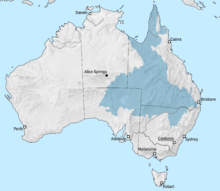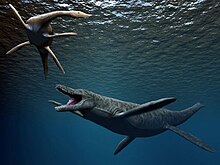Kronosaurus
However, it was 1924 that Albert Heber Longman formally described this specimen as the holotype of an imposing pliosaurid, to which he gave the scientific name K. queenslandicus, which is still the only recognized species nowadays.
In the early 1930s, the Harvard Museum of Comparative Zoology sent an organized expedition to Australia that recovered two specimens historically attributed to the taxon, including a well known skeleton that is now massively restored in plaster.
Phylogenetic classifications published since 2013 recover Kronosaurus within the subfamily Brachaucheninae, a lineage which includes numerous pliosaurids that lived during different stages of the Cretaceous.
Estimates of its bite force suggest that the animal would have reached between 15,000 to 27,000 newtons (3,370 to 6,070 lbf), surpassing the placoderm Dunkleosteus and rivaling Tyrannosaurus, but being largely outnumbered by the megalodon.
The fossil was officially described by De Vis's successor, Albert Heber Longman, in a scientific article published in 1924 by the journal of the Queensland Museum.
Longman would have created this generic name in reference to the imposing size and possible ferocity of the animal, which could recall the story of Kronos, who is known in Greek mythology for having devoured his own children, notably Zeus.
[3] These same fossils, all catalogued as QM F2137,[5][15] are identified as coming from the Toolebuc Formation, dating from the Albian stage of the Early Cretaceous, the holotype having very probably also been discovered in this same locality.
[16] The majority of the material recovered is then very incomplete, the only two that can be concretely described being proximal parts of propodials (upper limb bones),[5][3] which are analyzed in more detail the following year, and those again by Longman.
[17] In May and April 1935, a certain J. Edgar Young for the Queensland Museum, collected several fossils from the Toolebuc Formation, more precisely from the Telemon station, about 30 km west of Hughenden.
[19] The most notable specimen, cataloged as QM F2446,[20][5][4] consists of a partial middle of the skull which preserves an occipital condyle, the back of the neurocranium, the external nostrils as well as the orbits.
[23][24][11][7][25][21][16] This specimen was discovered long before the Harvard Expedition was even launched, by a rancher named Ralph William Haslam Thomas,[26] in a locality known as Army Downs.
[31] After two years of careful preparations with chisel and acid by Arnold Lewis and James A. Jensen under Romer's direction, their work ultimately cost slightly more than promised by Cabot's base check.
In response, professor and geologist Walter Heywood Bryan sent a message via telegraph informing journalists that it would be regrettable if such an important announcement made no mention of Longman and the interpretation of the initially fragmentary fossil material.
[7] At the age of 93, Thomas, the original discoverer of the specimen, was able to see the mounted skeleton of what he considered "his dinosaur", as well as meet again the leader of the museum's former expedition, each believing that the other had been dead for a long time.
According to Australian paleontologist Colin McHenry, the specimen has eight extra vertebrae added to the spine[21] and the skull is not supposed to have a bulbous shaped sagittal crest on top.
[34][35] Given that the holotype specimen of K. queenslandicus (QM F1609) is fragmentary and does not present any unique characteristics that would qualify the genus as distinct from other pliosaurs, the validity of this taxon has therefore been questioned.
As early as 1962, Samuel Paul Welles considered Kronosaurus as a nomen vanum and recommended the designation of a neotype specimen from Harvard University which would preserve the genus validity.
[49] The same year, Stephen F. Poropat and colleagues maintained K. queenslandicus as a nominally valid taxon that includes all fossils from the Toolebuc and Allaru Formation pending an official ICZN petition, recommending specimen QM F18827 as neotype.
[52] In 1982 and again in 1991, Ralph Molnar expressed doubts as to whether the Harvard skeleton (MCZ 1285) belonged to the species K. queenslandicus, given that it was discovered in a locality distinct from that of the first known specimens, namely in the older Wallumbilla Formation.
The specimen, nicknamed "El Fósil" and dating from the Upper Aptian of the Paja Formation, was first provisionally referred to the genus Kronosaurus two years later, in 1979.
[38] Due to the fact that the holotype specimen of Kronosaurus is non-diagnostic, the majority of anatomical descriptions are based on observations made from more complete fossils later assigned to the genus.
As early as 1930, Longman, in his description of propodiums, considered that Kronosaurus would have exceeded in size the imposing Megalneusaurus, a North American pliosaurid dating from the Late Jurassic.
[14][3][13] After the collection of fossils assigned to the genus by the Harvard Expedition, the maximum size of Kronosaurus was generally set at 12.8 meters (42 ft) long,based on specimen MCZ 1285.
Some characteristics that are shared by most brachauchenines like Megacephalosaurus includes skull features (such as an elongated snout, gracile rostrum, and consistently sized teeth) that are better adapted for a general evolutionary shift towards smaller prey.
[46][110] A 2019 study by palaeontologist Corinna Fleischle and colleagues found that plesiosaurs had enlarged red blood cells, based on the morphology of their vascular canals, which would have aided them while diving.
Using these techniques, McHenry discovered that Kronosaurus exceeded the bite force of any living animal, itself being only slightly surpassed in some estimates by the well kown theropod dinosaur Tyrannosaurus.
The estimates of this study regarding the bite force of these two pliosaurids exceed that of the predatory placoderm fish Dunkleosteus but are far from equaling that of the megalodon, to which the latter would have reached between 93,000 to 182,000 newtons (20,910 to 40,920 lbf).
[134] Chondrichthyans are also present, represented by Archaeolamna, Carcharias, Cretolamna, Cretoxyrhina, Edaphodon, Echinorhinus, Leptostyrax, Microcorax, Notorynchus, Pseudocorax, Pristiophorus, Scapanorhynchus and several species of orectolobiforms and palaeospinacids.
Numerous fragmentary remains of dinosaurs from specimens that probably perished after drowning in the waters of Eromanga are known, these being identified as coming from the sauropod Austrosaurus, the ankylosaurian Minmi and the ornithopod Muttaburrasaurus.
Indeed, a mandible cataloged as KK F0630, possibly representing a large subadult or a small adult specimen, shows bite marks which would have been made by lamniform sharks belonging to the Cretoxyrhinidae family.












